Interest Rates Rise, Recession Looms But Unemployment Still Low
Monthly Market and Economic Update – December 2022

Peter Flannery Financial Adviser CFP
“If you have one economist on your team,
it’s likely that you have one more than you’ll need.”
Warren Buffett
Key Points:
- Good news is bad news, is good news … the market gets confused.
- Inflation remains elevated, unemployment stays low, bad news for markets.
- Earnings revisions are underway, but not much – yet (?)
- Recession noise is getting louder.
- China opens up, and Britain loosens up, that’s positive for markets.
THE MARKETS
Where are we now and where to next?
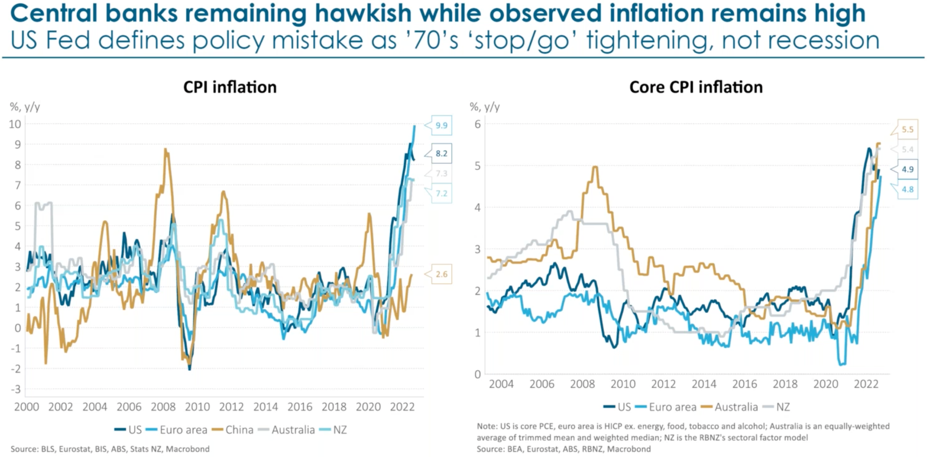
The graph on the left measures CPI inflation which is a broad measure of inflation. The graph on the right measures a narrower mix of inflation factors known as Core CPI inflation.
The point about the above graphs is that we can see inflation appears to be peaking which suggests perhaps a slowing down of interest rate rises in the US.
The US Federal Reserve is generally the main driver of interest rates globally. They appear ambivalent about recession with their main focus being to avoid a repeat of the mistakes made in the 1970s. Back then the US Fed hesitated, allowing inflation to become much more entrenched and more difficult to control.
This US Federal Reserve appears intent on continuing to drive rates as high as needed.
The markets appear to be shifting the focus from how high to how long with regard to interest rate hikes.
We’ve seen some upward repricing of share prices across the US market as peaking inflation is seen to be a positive, potentially leading to slower interest rate hikes from the market’s perspective. Remember, the market is generally forward looking.
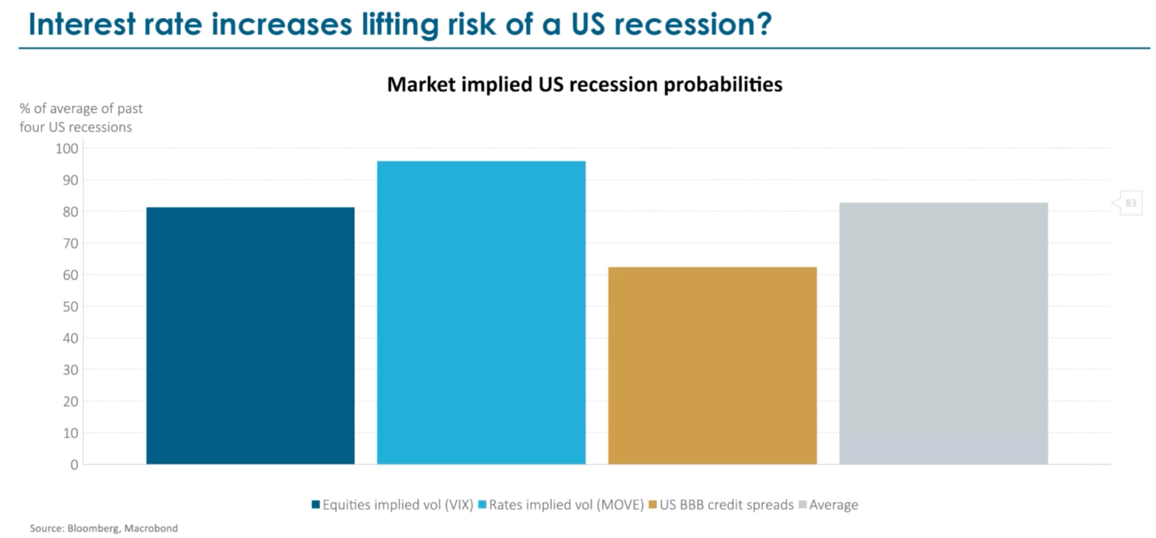
The above graph tracks the market’s perception of recession probabilities. The consensus appears to suggest an 83% chance of recession.
In many ways, recession is old news. The US has already been there in 2022 and likely to stumble into another in due course. As the graph above shows, the markets are pricing in that probability to a large degree.
We are continuing to see lots of “noise” about recession, although it remains to be seen and 2023 will provide the answers. However, the drama around it appears to be excessive when you look at the indicators more closely.
Recession matters for us as investors because it suggests there could be earnings revisions. Lower profits can mean lower trading prices. To be clear, the approach at WISEplanning is to look for the pricing opportunity in this environment rather than worrying about how bad things might be. Lower prices generally mean better buying.
The exception to the above point is when earnings decline which can stretch trading price valuations.
At this stage I see this as a process and a phase that the market will work its way through rather than the signal for serious economic recession or a massive share market crash. The indicators do not support either of those two scenarios currently.
So, expect some profit margin compression and some volatility around trading prices which again, will be our opportunity for better buying.
So, Where To Next?
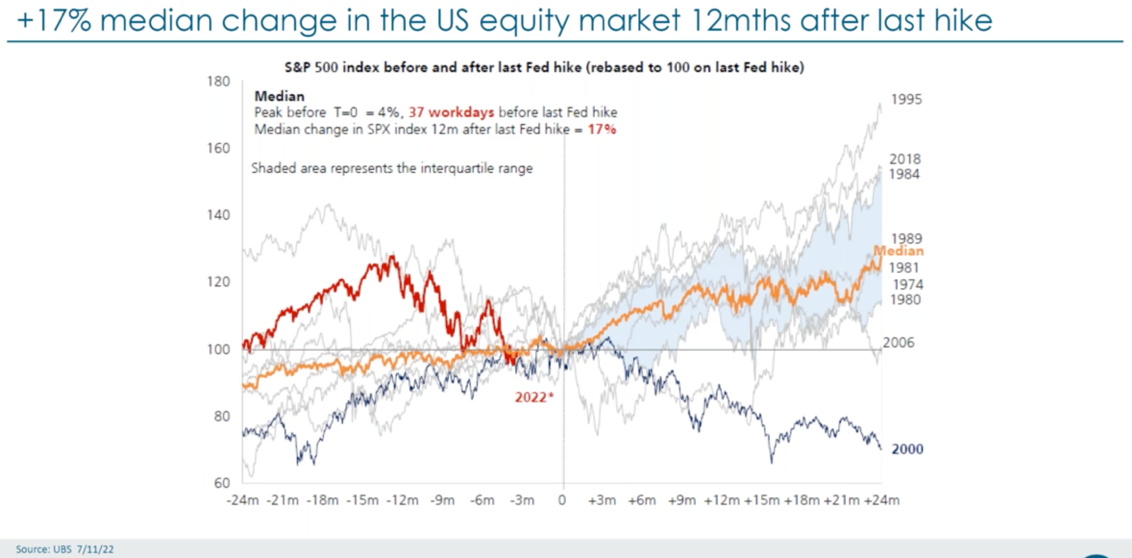
The above graph looks busy however it’s simply providing some different scenarios of how the share market has behaved 12 months after the last rate hike. Look down the right-hand column and you’ll see the years listed showing where the share market finished up after 24 months. Note the median outcome shown by the orange line.
Looking more closely at the chart above, the blue line in the right bottom quadrant for the year 2000 was the famous tech wreck bubble.
The red line in the top left quadrant shows where things are at so far this year. It’s difficult to predict however the median does provide some possible guidance as to where things may be heading.
As I mentioned earlier, there is limited data that support the year 2000 tech wreck bubble scenario and so we may see markets move more in line with that orange line.
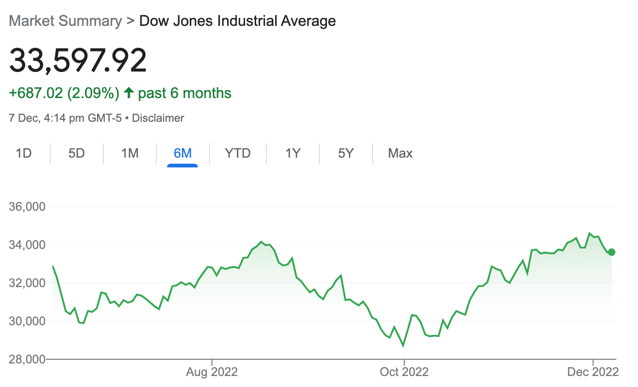
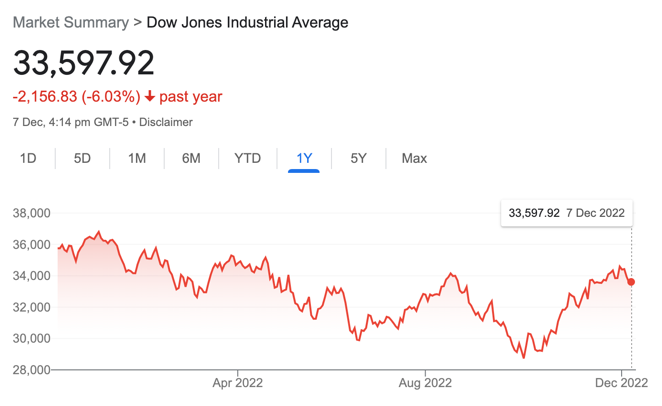
The chart on the left shows the US share market (the Dow Jones) over the last six months. The chart on the right shows the US share market (the Dow Jones) over the last year.
What About 2023?
Whilst predicting the future is not what will make us all rich, it does look as though we may see continued rate hikes from the US Fed (and the New Zealand Reserve Bank as well) although potentially at a slower pace which the markets will like.
Markets are generally volatile currently and I believe we’ll see ongoing moderately high levels of volatility as the market switches its attitude from time to time as data emerges.
Traditionally for example, rising unemployment is seen as a negative for the markets whereas in this environment, the markets may see it as a positive. That’s because they know it could mean a slowing down of interest rate rises, leading potentially to stabilisation and ultimately the possibility of interest rate cuts further into the future. Therefore, expect the market to change its mind about what it sees as good news and bad news.
At WISEplanning we’re relaxed either way because of course regardless of market and economic conditions, lower prices generally mean better buying and that is our focus – whether markets are good or bad or rising or falling.
For us it’s all about the business and the opportunity the trading price represents for us. The lower the better.
The Global Economy
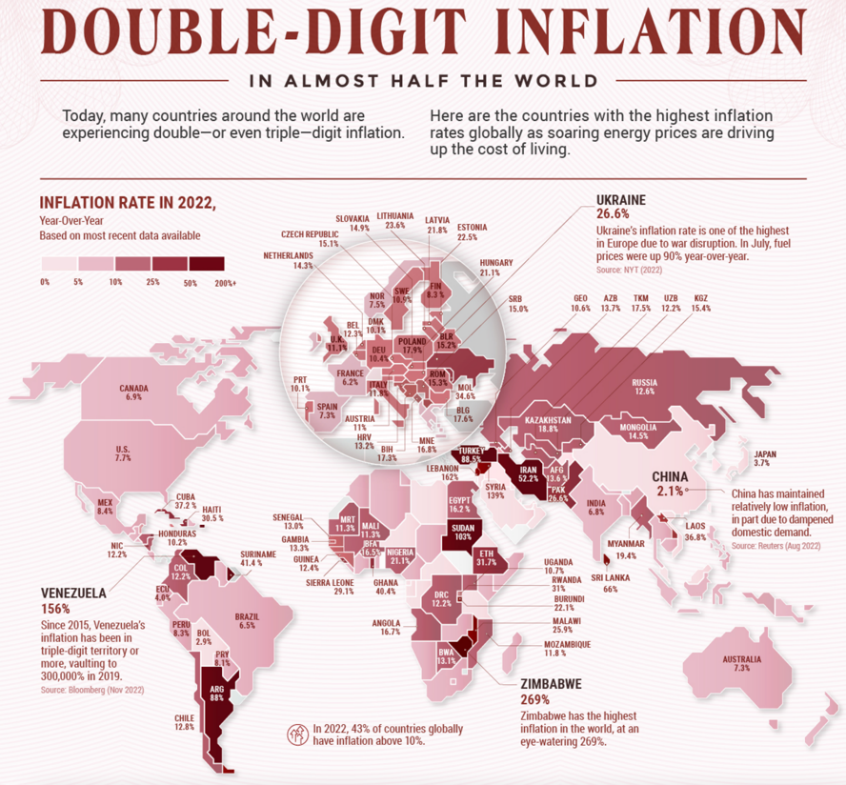
The above diagram shows the different levels of inflation that exist around the world.
Inflation remains relevant to the global economy. That’s because it has spiked up from unusually low levels to what could now be considered unusually high levels of inflation.
The problem with inflation is that it can reduce profit margins of businesses, in some cases making them run at a loss which of course, is not sustainable. Secondly it reduces the buying power of everyday citizens. They become worse off financially.
What we know is that inflation looks like it is peaking (in the US) however it still has quite a way to run yet.
However, the US Federal Reserve governor Jerome Powell and the New Zealand Reserve Bank governor Adrian Orr both appear steadfast in their resolve to get ahead of inflation.
That’s a good thing because, even though it may mean further interest rate hikes, we can all have a sense of greater certainty around central banks getting ahead of inflation. They seem determined to do so – a good thing.
Macro (Big Picture) Drivers Of Change.
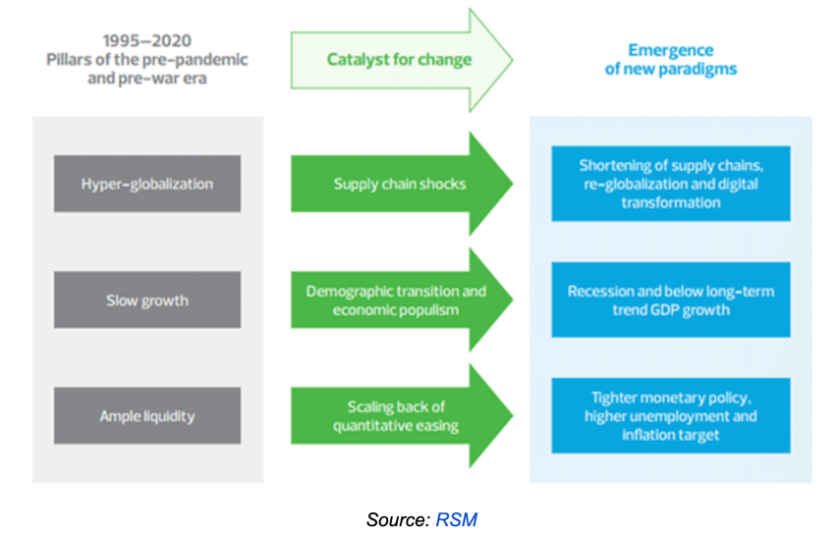
The above flow chart shows strategic shifts across the global economy that are underway currently.
For example, the green arrow right in the middle relating to demographic transition and economic populism suggests that the changing age wave could potentially impact on economic growth in the medium to long-term.
The idea is that in many developed countries, the majority of the population is getting older with fewer numbers of younger people coming up through. Simply, this could mean slower economic activity potentially.
This does seem logical, however in my experience these types of ideas, as valid as they sound, don’t often play out in the way that we might expect. In short, these macro trends are worth keeping an eye on but have limited impact on how we invest in the short-term.
The focus as you know is on the business and how well they use capital. Perhaps more importantly, the outlook and their future prospects are key. Quality businesses tend to provide greater reliability in this regard.
The United States of America
Personal Economic Consumption Expenditure Inflation
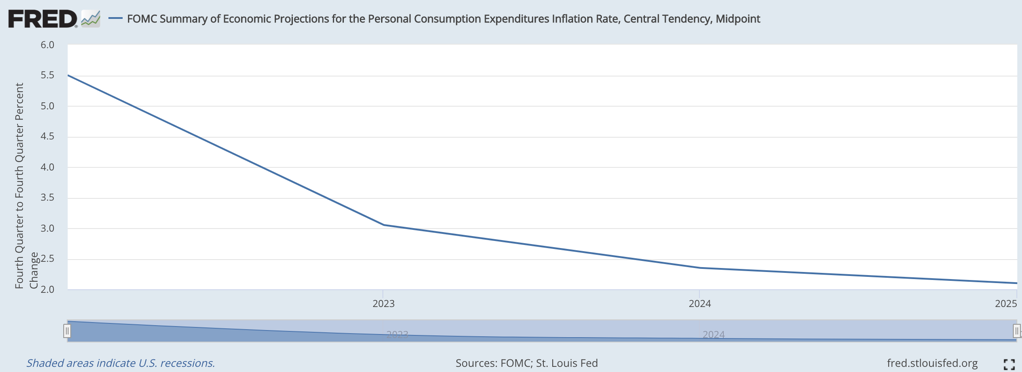
The above graph tracks the Federal Reserve’s projections for the Personal Consumption Expenditure (PCE) Inflation Rate in the US.
The graph immediately above is pertinent because this is a core inflation driver that the US Federal Reserve watches closely.
As you can see, it shows a steady decline over 2023 and into 2024, all things equal.
It is only a projection but one that the markets will be watching. This means that trading prices can rise on the back of this type of data in the future.
The point here is that markets don’t wait for everything to look nice. Usually, in the midst of uncertainty and turmoil is when trading prices change direction as we’ve likely seen mid-October this year. At least that’s the way it looks currently.
The Personal Consumption Expenditure (PCE) index rose at an annual pace of 6% in October, down from 6.3% the prior month and was below expectations. The core PCE price index, the Federal Reserves’ preferred closely watched gauge of inflation declined to 5% from 5.2%. Good news.
Unemployment – USA
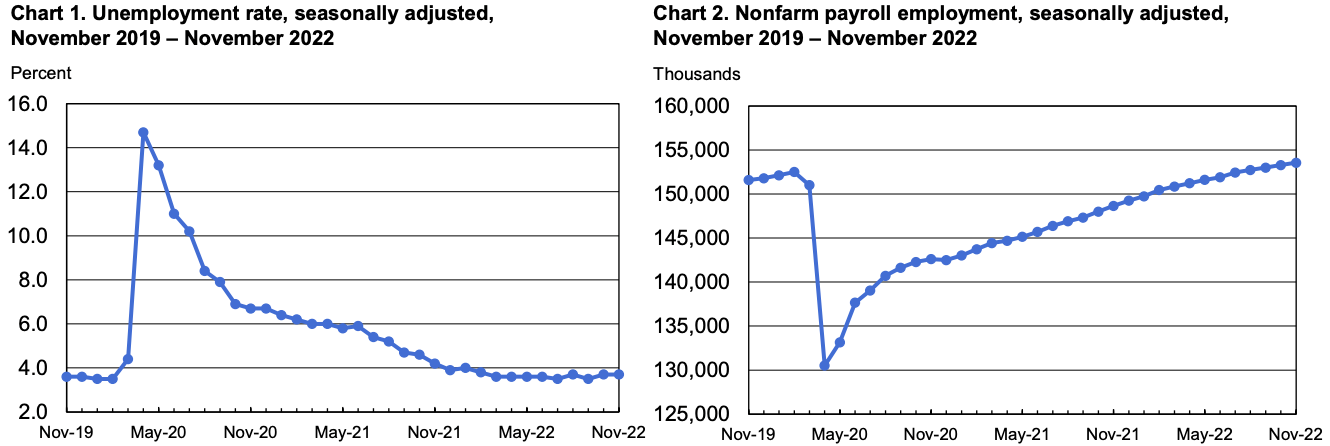
The graph on the left tracks the unemployment rate from November 2019 through November 2022. The graph to the right tracks the nonfarm payroll employment number from November 2019 through November 2022.
The unemployment rate in the US remained unchanged at 3.7% in November. It has been in a narrow range of 3.5% to 3.7% since March this year. The number of unemployed persons was basically unchanged at 6 million in November.
Perhaps of some concern to the US Federal Reserve was the average hourly earnings rate which rose 0.6% over the month of November. This was more than double most forecasts at 5.1% year-on-year which was also above expected consensus views.
Wages and the tight labour market in America continue to be troublesome for the US Federal Reserve.
Bargaining power still lies with the workers, placing upward pressure on wages.
Stubbornly low unemployment may be a strong driver of ongoing elevated inflation. This in turn could mean a lengthier period of elevated inflation and interest rates, or perhaps more subdued rate rises and a longer period of inflation.
Housing Prices – USA
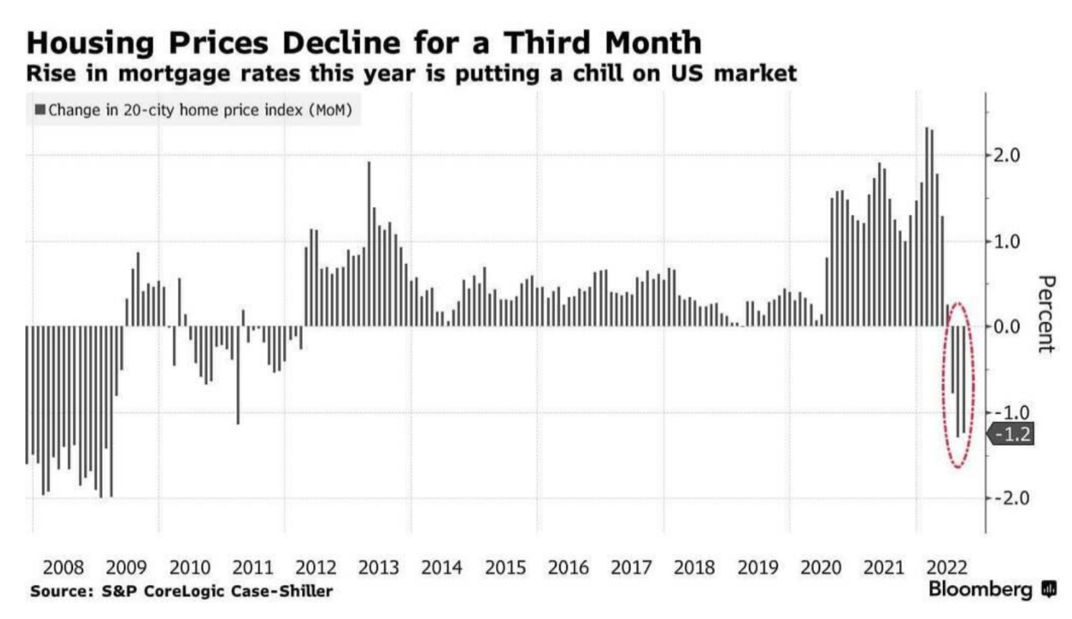
The above graph tracks house prices across the US.
On the other hand though, whilst unemployment remains stubbornly low, housing prices have declined for the 3rd straight month which has somewhat of a lagging effect but may nonetheless impact on wage and salary earners, pushing against high inflation. The US Fed will be pleased about declining house prices.
The US economy remains relatively stable and may well slip into recession at least once over the next 12 to 18 months. This will create volatility across markets which is ideal for us. This means that we can take advantage of better pricing along the way.
China
China looks like it is opening up once again.
There are signs of an easing in the zero-COVID controls.
They have been becoming somewhat tiresome for some Chinese citizens. It’s difficult to know whether the government is caving in to pressures as seen with the recent rioting in some provinces in China, or whether this is simply part of their plan to reinvigorate the economy.
Anyway, with China opening up, this may see the Chinese share market move up quite strongly for a bit and spread positive vibes across markets around the world.
Eurozone
Economic Growth – The Eurozone
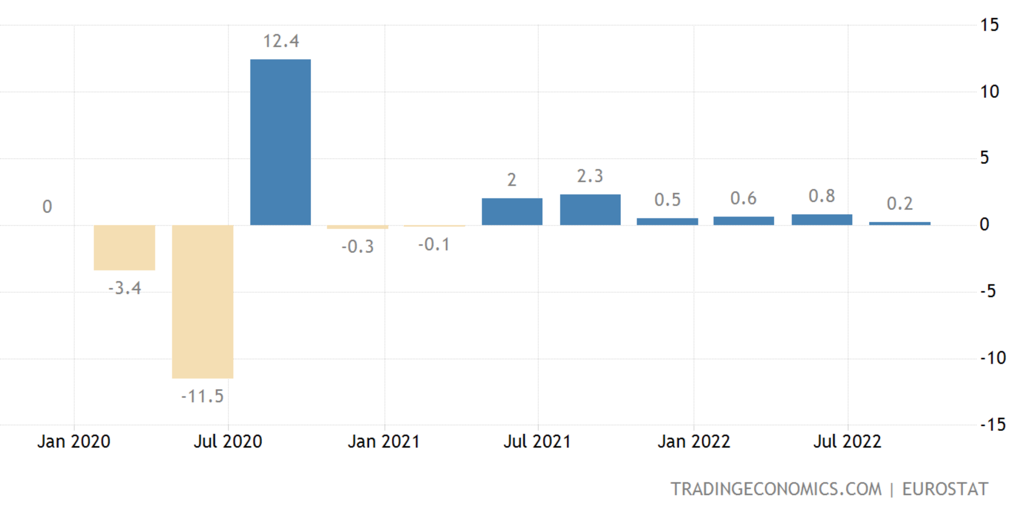
The graph above tracks economic activity across the Eurozone.
Economic growth across Europe remains subdued. As usual, there’s not much of a margin between economic growth and deflation. Still though, the economy across Europe remains reasonably stable.
Indications suggest that the Eurozone may fall into recession in the last quarter of this year and possibly the first 3 months in 2023. Then, there is the possibility of the economy returning to growth in the 2nd or 3rd quarter of 2023, according to the European Commission.
Predictably, high inflation and ongoing energy price spikes continue to erode householders’ purchasing power, while high interest rates and tighter military conditions are also making it more difficult for some.
Although fragile, the European economy remains relatively stable all things considered.
Australia
Residential Property Prices – Australia
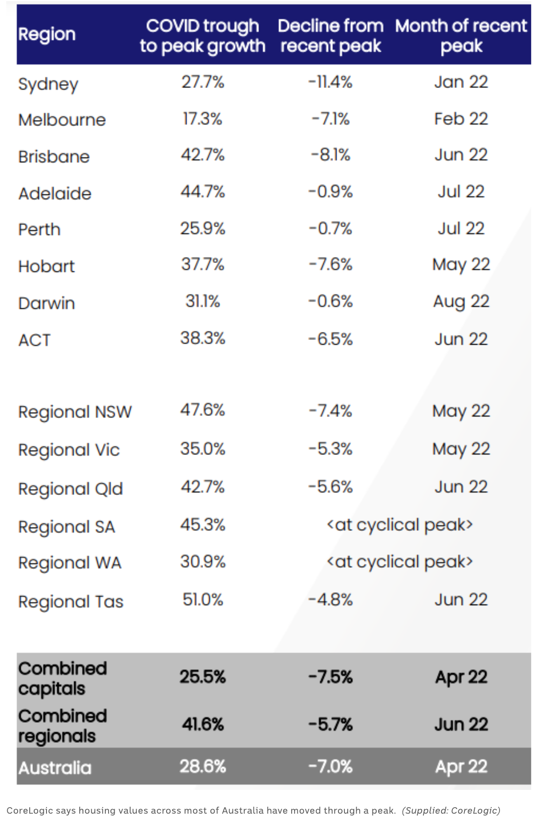
The above table shows the movement in residential property prices across Australia.
Australia has just seen one of the sharpest declines in housing prices on record, however this is on the back of a large property price upswing.
Sydney has seen property prices decline more than 10% from their peak however they are still much higher than pre pandemic.
Melbourne on the other hand did not see such large gains during the pandemic.
Prices in Melbourne are only 2.8% above where house prices were at with the onset of COVID, and looks to be on track to lose all of its COVID gains by around March next year.
CPI Inflation – Australia
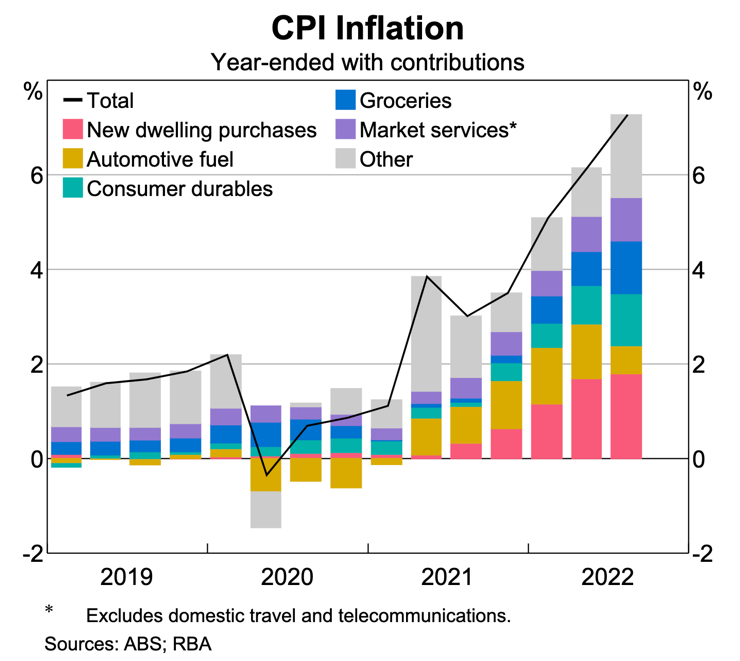
The above graph tracks annual inflation along with the components of inflation that make up the total.
Like elsewhere around the world, Australia has seen inflation spike although recent indications suggest inflation in Australia may be peaking.
Inflation remains broadly based as you can see from the graph above, with a number of inflationary components contributing to strong inflation over the last year.
Like elsewhere in the world, wage pressures continue to grow making the job of the governor of the Reserve Bank of Australia a bit more difficult in terms of trimming back spiking inflation.
Medium to long-term inflation projections however appear to be within the expected range of around 3% (still, the highest level since 2009).
So, more interest rate rises ahead for Australia but potentially at a slower pace now.
As an aside, the Australian share market generally represents better value than the New Zealand share market, with price earnings ratios sitting at around 12 or so, whereas in New Zealand, we are still at around 16 in terms of the price to earnings ratio across the market.
New Zealand

A 75 basis point increase in the official cash rate has recently taken place. The New Zealand Reserve Bank considered increases of 50, 75 and 100 basis points.
The committee agreed that a solid increase in the official cash rate was appropriate because of the resilient/optimistic spending here in New Zealand along with higher and more persistent actual inflation.
The next potential interest rate hike is scheduled for February 2023. It will be interesting to see how inflation behaves between now and then.
Along with the unemployment rate, other drivers of inflation will combine together to determine the size of the next interest rate rise then.
Interest Rates and Mortgage Rates – New Zealand
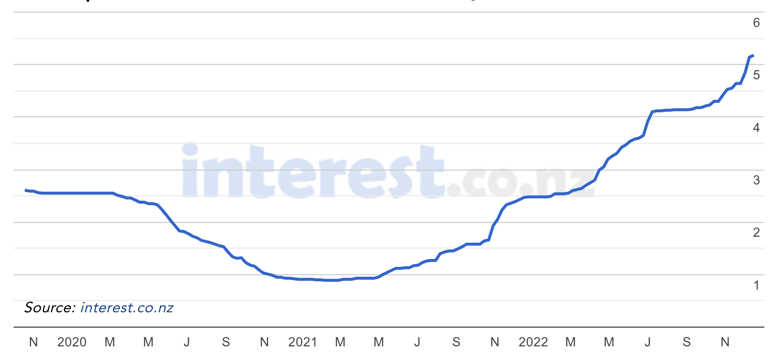
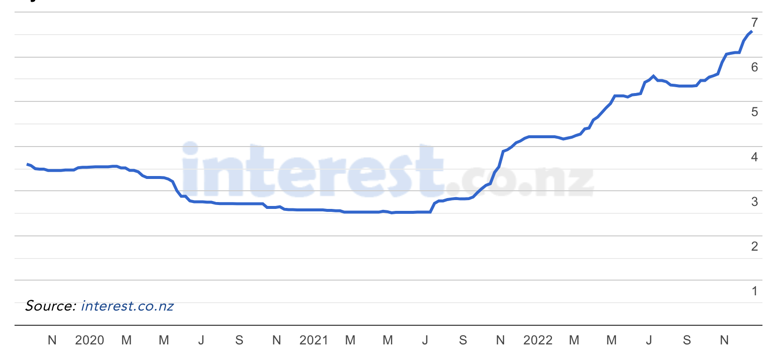
The graph on the left shows two-year bank term deposit interest rates. The graph to the right shows two-year mortgage interest rates.
Interest rates rise, which is good news or bad news depending on which side of the equation you sit.
For us investing in productive assets, it matters only in terms of how it affects trading prices. Generally, interest rates rise, asset prices decline. Interest rates decline, asset prices rise.
We’re now heading into a phase where interest rates have already caused trading prices to decline. Property prices may have further downside yet.
As I’ve mentioned previously, the share market tends to be forward looking whereas the property market tends to be more of a lagging indicator to some degree.
Anyway, for us as investors, it is about taking advantage of those lower trading prices whilst the market responds to rising interest rates.
Residential Property Prices – New Zealand
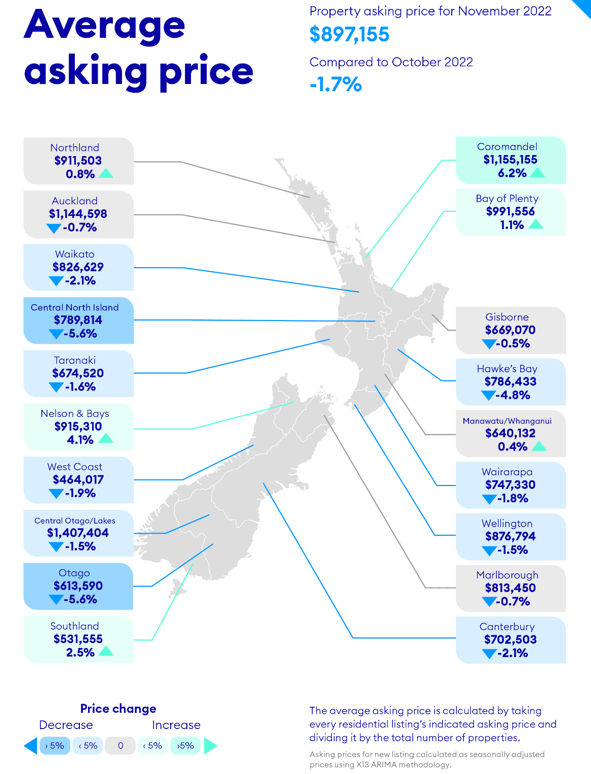
After peaking at around $992,000 in January 2022, in November the national average asking price fell below $900,000 for the first time since mid 2021.
Interestingly, despite the overall decline in housing prices across most of New Zealand, Bay of Plenty was up by 1.1%, Nelson & Bays jumped to 4%, Southland increased 2.5% and Coromandel jumped by 6.2%.
At this stage, we don’t see bargain basement pricing generally however properties are taking longer to sell.
The bottom line with residential property is that it is somewhat of a mixed bag however, overall we might expect prices to generally decline a bit further before stabilising.
Despite the fragile position of global markets, the New Zealand economy continues to remain stable and is doing okay.
With the 75 basis point rate hike from November behind us, it’s now a question of where to next with the New Zealand Reserve Bank and interest rates. They will be watching inflation behaviour along with unemployment between now and February 2023.
Unemployment remains stubbornly low which is not helping the New Zealand Reserve Bank to get ahead of inflation – at least not yet. Rising interest rates I suspect will bite over the next 3 months.
To Summarise
I’ve made no mention of the Russia/Ukraine situation. From a humanitarian perspective it’s difficult to think about it.
From an economic perspective it is contributing to rising inflation.
From an investor’s point of view, it has had limited impact.
As you may recall, I mentioned at the start of the war that history shows markets tend to finish higher after it has all finished, compared to when war began.
The US Fed continues to remain focused on getting ahead of inflation although it has signalled potentially a moderating pace of interest rate hikes ahead.
It’s too early yet to suggest interest rates have peaked, however inflation may have to some degree with perhaps a slower pace of US interest rate hikes ahead.
New Zealand on the other hand continues to press forward. It will be interesting to see the pace of the next interest rate rise in New Zealand in February 2023.
China appears to be relaxing its COVID-zero policy which the markets will like.
“Choppy seas ahead.” However, for investors it’s simply a matter of keeping a firm grip on “the tiller” and of course taking advantage of low hanging trading prices as they come along.
No need to rush.
Steady as we go.
We are on track.

